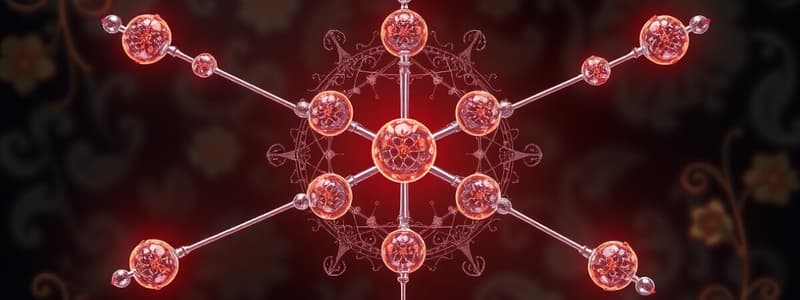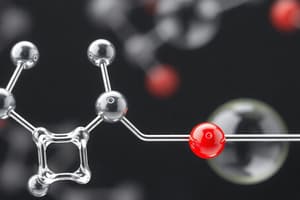Podcast
Questions and Answers
Which Lewis structure accurately represents the ionic compound formed between magnesium (Mg) and oxygen (O)?
Which Lewis structure accurately represents the ionic compound formed between magnesium (Mg) and oxygen (O)?
- Mg⁺[O]⁻
- Mg²⁺[O]²⁻ (correct)
- Mg[O]
- Mg-O
What distinguishes a polar covalent bond from a non-polar covalent bond?
What distinguishes a polar covalent bond from a non-polar covalent bond?
- Polar bonds occur between metals and non-metals; non-polar bonds occur between two non-metals.
- Polar bonds involve electron transfer; non-polar bonds involve electron sharing.
- Polar bonds are stronger than non-polar bonds.
- Polar bonds result from unequal sharing of electrons; non-polar bonds result from equal sharing. (correct)
Which molecule contains a double bond?
Which molecule contains a double bond?
- NH₃
- CH₄
- H₂O
- CO₂ (correct)
Why is satisfying the octet rule important when drawing Lewis structures?
Why is satisfying the octet rule important when drawing Lewis structures?
What is the net charge of any ionic compound?
What is the net charge of any ionic compound?
Which property is characteristic of ionic compounds?
Which property is characteristic of ionic compounds?
How are electrons described in metallic bonds?
How are electrons described in metallic bonds?
Which statement accurately describes covalent compounds?
Which statement accurately describes covalent compounds?
Which material is an example of a metallic element?
Which material is an example of a metallic element?
Why do ionic compounds have relatively high melting points?
Why do ionic compounds have relatively high melting points?
Which scientist discovered the electron?
Which scientist discovered the electron?
Which atomic model first proposed that electrons orbit the nucleus in fixed, quantized paths?
Which atomic model first proposed that electrons orbit the nucleus in fixed, quantized paths?
Which experiment is Ernest Rutherford best known for?
Which experiment is Ernest Rutherford best known for?
The modern atomic model describes electrons as existing in:
The modern atomic model describes electrons as existing in:
Which statement from Dalton's atomic theory is still considered correct today?
Which statement from Dalton's atomic theory is still considered correct today?
How does electronegativity change as you move from left to right across a period on the periodic table?
How does electronegativity change as you move from left to right across a period on the periodic table?
Which element has the highest electronegativity?
Which element has the highest electronegativity?
How does atomic radius generally change as you move down a group on the periodic table?
How does atomic radius generally change as you move down a group on the periodic table?
What is ionization energy?
What is ionization energy?
How does the number of neutrons vary in isotopes of the same element?
How does the number of neutrons vary in isotopes of the same element?
In what field is carbon-14 primarily used?
In what field is carbon-14 primarily used?
How is the atomic mass of an element determined, considering its isotopes?
How is the atomic mass of an element determined, considering its isotopes?
Which pair represents isotopes of the same element?
Which pair represents isotopes of the same element?
The primary difference between isotopes of an element lies in their number of:
The primary difference between isotopes of an element lies in their number of:
Which characteristic defines a polar molecule?
Which characteristic defines a polar molecule?
Flashcards
Sodium and Chlorine Lewis Structure
Sodium and Chlorine Lewis Structure
Na⁺ [Cl]⁻
Covalent Bond
Covalent Bond
A bond formed by sharing electrons between two non-metal atoms.
Molecule with a Triple Bond
Molecule with a Triple Bond
N₂
Lewis Structure Rule
Lewis Structure Rule
Signup and view all the flashcards
Overall Charge of an Ionic Compound
Overall Charge of an Ionic Compound
Signup and view all the flashcards
Typical property of ionic compounds
Typical property of ionic compounds
Signup and view all the flashcards
Metallic bonds
Metallic bonds
Signup and view all the flashcards
Covalent compounds property
Covalent compounds property
Signup and view all the flashcards
Material classified as a metallic compound
Material classified as a metallic compound
Signup and view all the flashcards
Reason for High Melting Points in Ionic Compounds
Reason for High Melting Points in Ionic Compounds
Signup and view all the flashcards
Who discovered the electron?
Who discovered the electron?
Signup and view all the flashcards
Model of the atom with electrons in fixed paths
Model of the atom with electrons in fixed paths
Signup and view all the flashcards
Scientist Associated with the Gold Foil Experiment
Scientist Associated with the Gold Foil Experiment
Signup and view all the flashcards
Modern Atomic Model Based On
Modern Atomic Model Based On
Signup and view all the flashcards
Dalton's Atomic Theory
Dalton's Atomic Theory
Signup and view all the flashcards
Electronegativity Trend (Left to Right)
Electronegativity Trend (Left to Right)
Signup and view all the flashcards
Element with Highest Electronegativity
Element with Highest Electronegativity
Signup and view all the flashcards
Atomic Radius Increase
Atomic Radius Increase
Signup and view all the flashcards
Trend moving from top to bottom in a group
Trend moving from top to bottom in a group
Signup and view all the flashcards
Ionization energy
Ionization energy
Signup and view all the flashcards
Isotope
Isotope
Signup and view all the flashcards
Use of Carbon-14
Use of Carbon-14
Signup and view all the flashcards
Atomic mass
Atomic mass
Signup and view all the flashcards
Example of Isotope
Example of Isotope
Signup and view all the flashcards
Difference in Isotopes
Difference in Isotopes
Signup and view all the flashcards
What a Polar Molecule Will Have
What a Polar Molecule Will Have
Signup and view all the flashcards
Most Likely Non-Polar Bond
Most Likely Non-Polar Bond
Signup and view all the flashcards
Polar Covalent Bond Occurs When
Polar Covalent Bond Occurs When
Signup and view all the flashcards
Non-Polar Molecule with Polar Bonds
Non-Polar Molecule with Polar Bonds
Signup and view all the flashcards
Strongest Dipole-Dipole Forces
Strongest Dipole-Dipole Forces
Signup and view all the flashcards
Study Notes
Drawing Ionic and Covalent Compounds
- The correct Lewis structure for the ionic compound formed between sodium (Na) and chlorine (Cl) is Na⁺ [Cl]⁻.
- A covalent bond forms between two non-metal atoms in a covalent compound.
- N₂ has a triple bond.
- When drawing the Lewis structure of a molecule, one rule to follow is that all atoms must have a complete outer electron shell.
- The overall charge of an ionic compound is neutral.
- Magnesium chloride (MgCl₂) is an ionic compound formed through the transfer of electrons from magnesium to chlorine, resulting in Mg²⁺ and two Cl⁻ ions.
- Ionic compounds conduct electricity when dissolved in water due to the mobility of ions, whereas covalent compounds generally do not conduct electricity under any conditions unless they undergo ionization or have free-moving electrons.
Properties of Ionic, Covalent, and Metallic Compounds
- High solubility in water is a property typical of ionic compounds.
- Metallic bonds are best described as electrons pooled and free to move around.
- Covalent compounds are poor conductors of electricity in all states.
- Copper (Cu) would be classified as a metallic compound.
- Ionic compounds tend to have high melting points because the bonds between ions are very strong and require significant energy to break.
- Ionic compounds like sodium chloride conduct electricity when dissolved in water because the ions are free to move and carry charge, but they do not conduct electricity in their solid state because the ions are held in fixed positions within the crystal lattice.
- Metallic copper exhibits malleability and conductivity due to its structure of positive ions immersed in a "sea" of electrons, allowing electrons to move freely and ions to slide past each other without breaking bonds, whereas sulfur, a covalent network solid, is brittle due to its directional bonds that break under stress.
History of the Atomic Model
- J.J. Thomson is credited with the discovery of the electron.
- Bohr’s model of the atom proposed that electrons orbit the nucleus in fixed paths.
- Ernest Rutherford is most associated with the “gold foil” experiment.
- The modern atomic model is based on the principles of electron clouds.
- A correct statement about Dalton’s atomic theory that atoms are indivisible and indestructible.
- Rutherford's model introduced the concept of a small, dense, positively charged nucleus surrounded by empty space, while Thomson's model proposed a "plum pudding" structure with electrons dispersed throughout a positive matrix. These discoveries challenged the earlier view of the atom as an indivisible, uniform sphere.
- The concept of the atom has evolved from Dalton's indivisible sphere to the quantum mechanical model through a series of experimental findings, including Thomson's discovery of electrons, Rutherford's nuclear model, and Bohr's quantized orbits, each leading to refinements based on new evidence and a progressively more accurate understanding of atomic structure.
Periodic Trends
- As you move across a period from left to right on the periodic table, the electronegativity of elements increases.
- Fluorine (F) has the highest electronegativity.
- Atomic radius generally increases as you move from top to bottom down a group.
- As you move from top to bottom in a group on the periodic table atomic radius increases.
- The ionization energy of an element is defined as the energy needed to remove an electron from a neutral atom.
- Fluorine has a higher electronegativity than iodine because fluorine is smaller, resulting in a greater effective nuclear charge that attracts bonding electrons more strongly.
- Ionization energy increases across a period due to increasing nuclear charge and decreases down a group due to increased electron shielding; these trends relate to the number of protons and the electron shielding effect by affecting how strongly the nucleus attracts the outermost electrons.
Isotope Calculations, Definition, and Uses
- An isotope of an element has the same number of protons but different numbers of neutrons.
- The isotope carbon-14 is used in radiocarbon dating.
- The atomic mass of an element is the average mass of all its isotopes, weighted by abundance.
- Carbon-12 and Carbon-14 are examples of an isotope.
- Isotopes differ in their number of neutrons.
- With Isotope A having a mass of 10.0 amu and an abundance of 60%, and Isotope B having a mass of 11.0 amu and an abundance of 40%, the average atomic mass calculates to 10.4 amu by multiplying each isotope's mass by its abundance and summing the results.
- Isotopes are used in medicine for diagnostic imaging and therapeutic treatments, such as radioactive iodine for thyroid disorders. While these applications offer benefits like precise targeting, they also carry risks associated with radiation exposure, including potential harm to healthy tissue.
Polar and Non-Polar Covalent Compounds
- A molecule that is polar will have a net dipole moment.
- Cl-Cl bond is most likely to be non-polar.
- A polar covalent bond occurs when the electronegativity difference between two atoms is significant.
- CO₂ is non-polar despite having polar covalent bonds
- In H₂O, the dipole-dipole forces will be the strongest.
- CO₂, despite having polar bonds, is a non-polar molecule due to its linear geometry, which cancels out the bond dipoles, resulting in no net dipole moment.
- A non-polar substance will not dissolve well in water due to the lack of attraction between non-polar molecules and polar water molecules; non-polar substances prefer to interact with other non-polar substances.
Studying That Suits You
Use AI to generate personalized quizzes and flashcards to suit your learning preferences.



